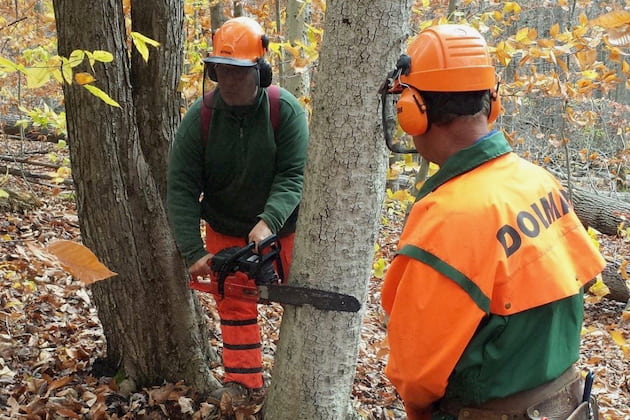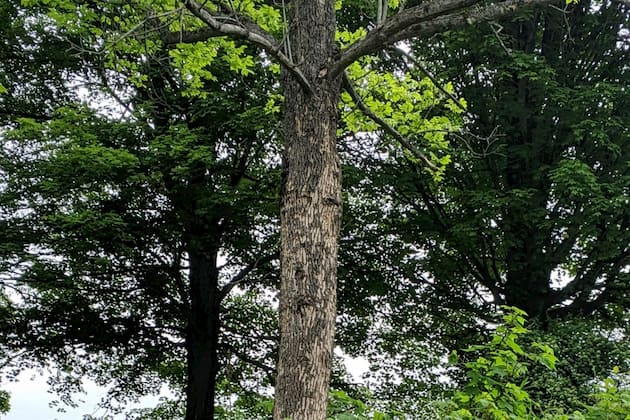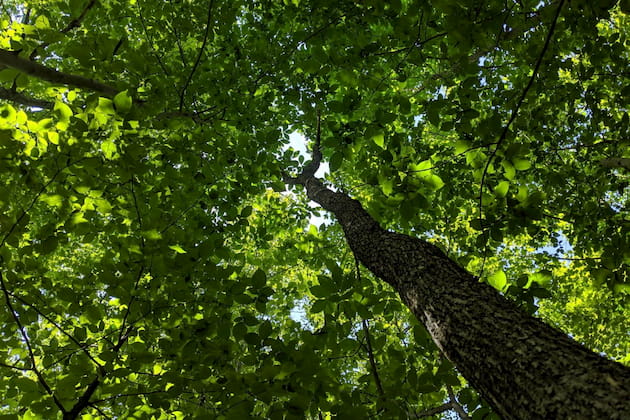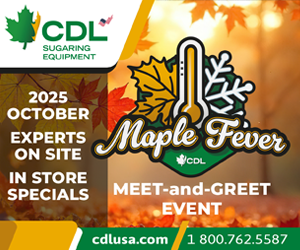Sugarbush Management
What to do about the dead ash in your woods
After Emerald Ash Borer: Considering What to Do When Canopy Trees Die in Your Woodlot
By PETER SMALLIDGE, NYS EXTENSION FORESTER AND DIRECTOR, ARNOT TEACHING AND RESEARCH FOREST | JUNE 22, 2020
ITHACA, N.Y.—The emerald ash borer will have significant impacts on eastern hardwood forests.
In many areas the impact has happened.
Unfortunately, all of the mature ash are likely to die once EAB establishes and spreads in a woodlot.
Current research and corresponding field trials are evaluating the efficacy of parasitoid wasps and other biocontrol agents, but their greatest impact is likely to offer hope for ash seedlings and saplings.
More information about the EAB biocontrol program is available at http://www.emeraldashborer.info/biocontrol.php.
The current characteristics of woodlots will dictate the owner’s options and what the woods will look like in the aftermath of EAB-induced mortality.
The future characteristics depend upon each woodlot’s trajectory; management can influence though not fully direct the trajectory and thus the outcome.
Emerald ash borer has been known to New York since 2009. It is throughout most areas of western and southern NY, and expanding along the eastern and western borders of the Adirondacks.
A map of EAB in NY is available here https://www.dec.ny.gov/docs/lands_forests_pdf/eabdistribution2019.pdf
Early symptoms of EAB include marginal leaf feeding by the metallic green adults. The adults lay eggs in small holes they create in the surface of the bark, and the eggs hatch into larvae that feed in phloem beneath the bark and the outer layers of wood.
The larval galleries girdle the tree. Once larvae have infested the tree, woodpeckers arrive, in search of the larvae.
The action of the woodpeckers isn’t sufficient to control EAB but results in a diagnostic symptom called “blonding” as a result of pecking on the bark.
Once blonding starts, the abundance of larvae is sufficient that tree death is imminent usually within a year or two.
An abundance of information about this pest is available at www.emeraldashborer.info and in past issues of the New York Forest Owner magazine (www.nyfoa.org).
Emerald ash borer is one of the latest introduced species-specific pests.
The 20th century included the near complete loss of American chestnut from chestnut blight, significant reduction of American elm from Dutch elm disease and elm yellows, drastically altered growth and ecology of American beech from beech bark disease, and extensive mortality to oak from gypsy moth.
The current century includes concerns for potentially similar impacts to eastern hemlock from the hemlock woolly adelgid, the red oak subgenus from oak wilt, and sugar maple from Asian long-horned beetle.
The most recent pest is the spotted lantern fly, and that has a broad spectrum of hosts. Fortunately research efforts are active for all these pests.
The forest pests of the past can provide guidance for how woodlot management efforts might influence the outcome of EAB. As with all decisions, management efforts should be guided by owner objectives.
The factors that will most likely influence management action in the woodlot before and after EAB include the following, which are discussed below:
- Safety
- Land owner objectives
- Ash markets and timeliness of response
- Abundance of ash in the overstory
- Stand size class and ash DBH
- Deer impact and understory condition
- Landowner investment
Safety considerations before EAB-induced mortality occurs include standard protocols for working in the woods, such as appropriate training and the use of personal protective equipment.
With the onset of tree mortality, access to the woods is increasingly risky. With high levels of tree mortality, work should be restricted to trained professionals with appropriate equipment.
With high levels of tree mortality, many management actions are precluded. Owners should work with their forester to develop a plan that can be implemented before tree mortality happens.
All decisions of woodlot management should be based upon and consistent with ownership objectives. Some of the management options described here depend upon owner objectives.
For example, an ownership objective for timber revenue might be realized sooner than initially planned if there are significant numbers of sawlog sized ash. (Note – talk to your forester about the silvicultural implications of an ash salvage harvest, which is not discussed here)
Or, if the trees are smaller, there may be no significant revenue potential.
An ownership objective for a tall closed-canopy forest, given abundant dead ash, might be at least temporarily stalled or with a prolonged and expensive delay.
Access for firewood, recreation, maple syrup, etc. will be complicated by the presence of dead standing ash trees.
In the time since EAB has been known in N.Y., the market for ash sawlogs has remained fairly strong. What might have been a surplus of logs and reduced pricing has not happened.
The future market is unknown.
The potential for accessing these markets depends on having a harvest prior to mortality.
The option for logging is usually lost when canopy trees start dying due to logger safety and the tendency for dead ash to fracture on impact.
Markets are not available for all sizes of ash, but the presence of seedlings, saplings and small poles provide a genetic reservoir of ash.
While there are no restrictions on the sale of standing trees with EAB, the buyer may be restricted in where those log are delivered.
The abundance of ash is the most significant determinant of the impact that EAB will have in a woodlot.
In woods with relatively few or isolated ash, their mortality will have minimal impact on the functioning of the ecosystem. In contrast, some woodlots have significant amounts of ash, and their mortality will fundamentally change the look and function of that ecosystem.
Ash is rated as mid-tolerant of shade and can occur in lower canopy position. However, ash usually occupies mid- to upper-canopy positions.
Ash mortality within these upper positions will allow for increased sunlight to the subcanopy and forest floor, and increased growth from understory plants.
Owners can assess the abundance of ash in upper and lower crown positions to forecast how light levels will change and the species that will benefit from increased light.
Stands of commercial size class may have the potential to generate revenue.
If owner objectives align with the process of a timber harvest, planning should begin before there is evidence of EAB. There is no obligation to harvest the ash, but as trees die they create hazards for work or recreation in the woods.
Pole sized trees (5” to 11” diameter breast height, dbh) may have utility as firewood. Commercial logging crews seldom harvest just pole-sized firewood because the profit margin is small.
Unless previously recommended in your management plan, be cautious of the temptation to add additional non-ash stems to a timber sale to “sweeten the pot.”
Also, be cautious about friends, relatives and neighbors who offer to help by cutting and removing ash firewood; they may lack the necessary skill and equipment to work safely and effectively, or to limit damage to desirable residual trees.
In many areas, selective deer browsing has reduced the abundance of desirable species (e.g., maple, basswood, oak, cherry, etc.) and favored the growth of typically undesirable species (e.g., beech, hophornbeam, invasive shrubs, etc.).
Deer impact is the combined effect of deer abundance and forage abundance; if deer abundance exceeds forage abundance then desirable species in the woodland understory suffer.
Without action that controls deer impacts and the proliferation of undesirable species, woodlots with an abundance of ash and undesirable species will likely shift to a woodland that is low-diversity, low-canopy, and reduced productivity.
Recreational hunting alone is seldom sufficient to limit deer impacts. Consider options such as fences, cages, slash walls or other effective barriers, plus adequate light, to protect desirable seedlings.
Most management actions require some investment of time or money by the owner.
In other cases, the owner may work with a forester to arrange a harvest to accomplish the majority of work. Some owners will benefit by a harvest with low revenue that accomplishes their objectives without work on their part.
An updated management plan can help owners plan the sequence of operations that optimize their resources and minimize investments.
Some cost-share funds may be available, but these are insufficient to provide for all of the work of owners impacted by EAB.
Check with your forester to see what cost-share funding might be available in your area, what process is required, and then act as quickly as possible.
Some of the strategies to influence the trajectory of your woods will involve cutting trees.
Owners without experience in the harvesting process will benefit by being able to visualize what different types of harvests look like.





































